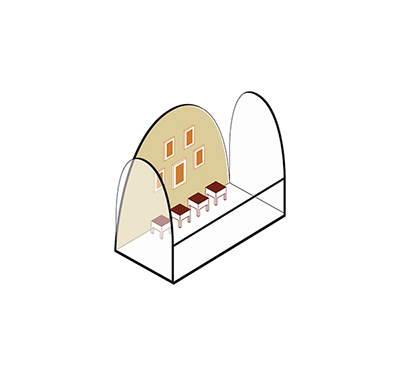Mahaparinirvana Stupa – Stupa of the Great Perfect Nirvana
See it in the Museum

Emporium
Orientation 2
Furniture 5

ABR 006
Code: ABR 006
Country: Tibet (central)
Style:
Date: 1150 - 1350
Dimensions in cm WxHxD: 17.5 x 33.5 x 18
Materials: Brass
Mahaparinirvana Stupa – “Stupa of the Great Extinction”
The stupa, or chöten in Tibetan, is a significant religious monument in Buddhism and serves as a reliquary for the remains of eminent masters. Stupas are also portable works of art created from precious materials, as is the case here.
In Tibet, stupas all share a similar general structure with symbolism associated with the elements: a stepped square base for earth, a cylindrical “vase” for water, a conical spire for fire, a parasol for air, and at the top the sun and moon representing space and wisdom. They are often found in groups of eight, each stupa representing one of the eight most important events in the life of Buddha, which is expressed in a specific shape.
This stupa commemorates the Buddha’s Mahaparinirvana or his “passing away beyond suffering” at Kushinagar. At the end of his life, being aged and ill, he is said to have lied on his side between two sal trees before entering in the state of complete extinction. Unlike the usual models, the round base is formed by a lotus rather than a square pedestal. The distinctive bell-shaped dome is circular, adorned with two lines and topped by a balustrade. Above it, discs of decreasing diameter are stacked to form a cone, topped by a parasol and the symbols of the sun and moon along with a swirling scarf. At the pinnacle is a small effigy of a blazing triple gem representing the Three Jewels of Buddha, Dharma and Sangha. In Tibet, this type of stupa is also called “Kadampa stupa”—named after the Tibetan school founded by the Indian master Atisha.
The stupa, or chöten in Tibetan, is a significant religious monument in Buddhism and serves as a reliquary for the remains of eminent masters. Stupas are also portable works of art created from precious materials, as is the case here.
In Tibet, stupas all share a similar general structure with symbolism associated with the elements: a stepped square base for earth, a cylindrical “vase” for water, a conical spire for fire, a parasol for air, and at the top the sun and moon representing space and wisdom. They are often found in groups of eight, each stupa representing one of the eight most important events in the life of Buddha, which is expressed in a specific shape.
This stupa commemorates the Buddha’s Mahaparinirvana or his “passing away beyond suffering” at Kushinagar. At the end of his life, being aged and ill, he is said to have lied on his side between two sal trees before entering in the state of complete extinction. Unlike the usual models, the round base is formed by a lotus rather than a square pedestal. The distinctive bell-shaped dome is circular, adorned with two lines and topped by a balustrade. Above it, discs of decreasing diameter are stacked to form a cone, topped by a parasol and the symbols of the sun and moon along with a swirling scarf. At the pinnacle is a small effigy of a blazing triple gem representing the Three Jewels of Buddha, Dharma and Sangha. In Tibet, this type of stupa is also called “Kadampa stupa”—named after the Tibetan school founded by the Indian master Atisha.


